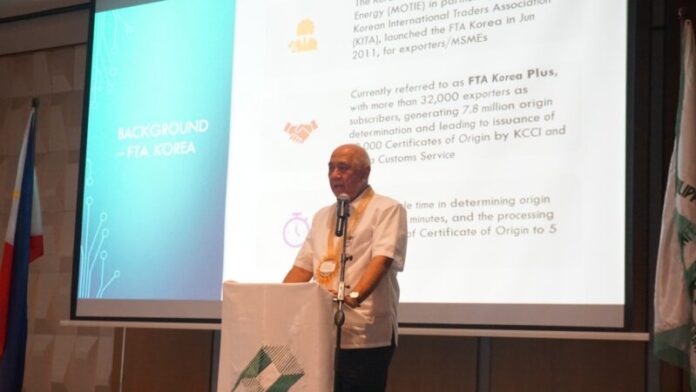
-
The information portal and origin management system aimed at promoting and streamlining use of free trade agreements in the Philippines will be launched this year and next, respectively
-
The FTA information portal will be launched in time for the Exporters’ Congress in December, and the origin management system in the third quarter of 2025
-
The two initiatives are major components of a project between the Department of Trade and Industry and the Korea Institute for Advancement of Technology
An information portal and origin management system aimed at promoting and streamlining the utilization of free trade agreements (FTA) in the Philippines will be launched in the last quarter of 2024 and the third quarter of 2025, respectively, according to InterCommerce Network Services, Inc. (INS) president Francis Norman Lopez.
In a presentation during the Philippine Exporters Confederation, Inc.’s recent general membership meeting, Lopez said the FTA information portal will be launched in time for this year’s Exporters’ Congress in December.
The origin management system (OMS), meanwhile, is targeted for launch in the third quarter of next year.
The information portal and OMS are the two major components of a project between the Department of Trade and Industry (DTI) and the Korea Institute for Advancement of Technology (KIAT) that officially commenced following the signing of the Record of Discussions on November 29, 2023.
READ: PH, Korea to develop origin management system
The project aims to enhance the international competitiveness of micro, small, and medium enterprises, increase the utilization of existing Philippine FTAs and preferential trade arrangements, and reduce the time and costs of Philippine manufacturers and traders to comply with rules of origin (ROO) requirements of FTAs and Generalized System of Preferences (GSP).
Korea Trade Network (KTNET), the Korean government’s designated trade automation business service provider, will implement the project with INS as its partner. The DTI-Export Marketing Bureau will take the lead in implementation on the Philippines’ side.
INS will help maintain the system, which will be Cloud-based, once it is transferred to DTI. INS and KTNET last March 5 signed an agreement to develop and implement the OMS.
READ: InterCommerce, Korean partner developing system for FTA promotion
“We see the immense potential in this project to boost the development and growth of Philippine exports by simplifying the exporting process and leveraging FTAs/GSP,” DTI undersecretary Ceferino Rodolfo said in a statement.
The FTA information portal will be a dynamic and user-friendly platform that will contain information on FTAs and GSPs that the Philippines has entered into.
The OMS, meanwhile, will enable exporters to assess whether their export product qualifies under the relevant rules of origin requirements of FTAs/GSPs by inputting necessary information.
An AI-enabled Harmonized System (HS) classification tool will assist exporters in determining the appropriate HS code/s for their product/s.
Aside from enabling exporters to check whether their products qualify for rules of origin requirements, Lopez said that through the OMS, exporters can submit applications to the Bureau of Customs (BOC) for the product evaluation report (PER), if the product is qualified under a specific FTA origin criterion.
Upon approval, the exporter will be informed that the product is qualified, and product details will be uploaded into BOC’s electronic certificate of origin (e-CO) platform.
With the BOC Export Coordination Division approval of the PER, the exporter will have a link to apply for the CO in the e-CO platform.
Currently, BOC’s e-CO platform is used for the issuance of e-COs to secure preferential tariff under the Association of Southeast Asian Nations Trade in Goods Agreement.
The OMS will also be capable of integrating with the own enterprise resurge planning systems of businesses so they can just upload their data instead of separately encoding in the OMS.
Lopez said the OMS will help address the challenges in FTA utilization.
He noted FTA utilization in the Philippines is just around 40-50%.
In South Korea, KTNET president and chief executive officer Young-hwan Cha earlier said utilization of FTAs increased from around 60% to 82% last year when they implemented their FTA origin determination service called Korea FTA Plus.
Cha said the Philippines will be the first country outside South Korea where the system will be implemented. – Roumina Pablo




